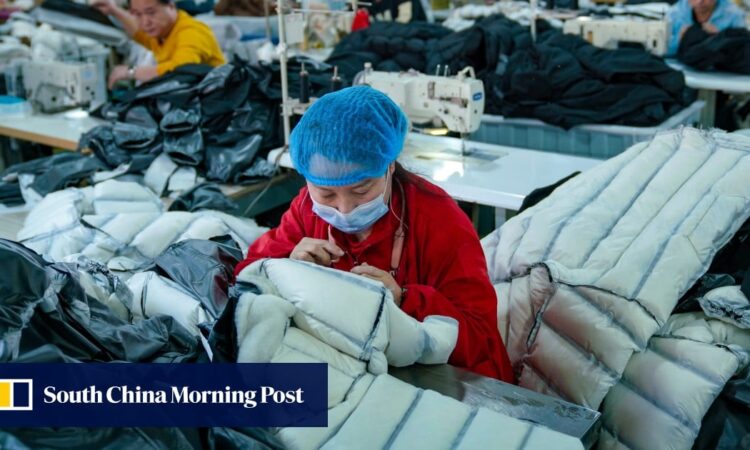
Despite a shared interest in reorienting the US economy away from China, the two administrations have employed different rhetoric to describe their deeds.
Re-industrialisation, once it starts, is hard to reverse because it is cost effective
While Lighthizer refers to a process of “strategic decoupling” in his book, Biden and his officials have said the US is “de-risking”. Regardless, the results have been similar: stricter controls on China accessing hi-tech components and know-how.
Alongside the game plan dubbed “small yard high fence” – where certain decisive sectors are given stringent protection as economic relations are maintained – the US is pushing for a diversification of supply chains led by itself and its allies.
Though these efforts go by several names, including “friendshoring”, “reshoring” and “near-shoring”, the Chinese government regards all as forms of decoupling.
With China policy almost certain to be a marquee issue in November’s presidential election, and bipartisan consensus on the need for containment unlikely to wane in the near future, analysts are urging Beijing to adapt to the situation by opening itself wider.
Where are China’s exports going? Less and less to the US – at least directly
Where are China’s exports going? Less and less to the US – at least directly
“Geopolitical conflicts will not stop in the short term,” said Qiu Dongxiao, head of the economics department at Lingnan University in Hong Kong.
He added unemployment is the main driver for Washington’s re-industrialisation, and warned the present trend could last more than 10 years.
“Re-industrialisation, once it starts, is hard to reverse because it is cost effective. [It] involves a lot of investment which has been sunk.”
US manufacturing investment in 2022 rose 10.5 per cent from the year before, reaching US$670.5 billion according to Chinese data provider Wind – up 54 per cent compared to a decade earlier.
The Reshoring Initiative, a US-based private think tank, has projected nearly two million manufacturing jobs have been brought back to the country since 2010, and this trend is only accelerating.
“It took 11 years to return the first million jobs and only 3 years to return the second,” it said in a report on data from the first half of 2023.
The US added 364,000 manufacturing jobs in 2022, up 53 per cent from the year prior. About half were created in the chip and electric vehicle industries, while appliances, chemicals and electrical equipment and chemicals also saw a strong influx.
China, meanwhile, reported a 10.3 per cent fall of direct investment from the US the same year. Mexico has also replaced it as the US’ largest trading partner, moving ahead in early 2023.
Ye Yu, assistant director of the Institute for World Economy Studies at the Shanghai Institutes for International Studies, said US curbs could still end up backfiring, citing the example of Huawei Technologies.
The Chinese tech giant unexpectedly unveiled its Mate 60 handset last September during US Commerce Secretary Gina Raimondo’s visit to China, a breakthrough in indigenous chip design made despite restrictions on access to cutting-edge components.
“The service sector is a strength of the US, but it’s hard for them to build a comprehensive supply chain for innovative industries within America. Just look at the strike of their automobile workers, you’ll see the impact,” Ye said.
“Another issue will be whether robots can be developed to replace human workers, but there are a lot of uncertainties,” she explained.
“That’s why manufacturers will move to Mexico and Vietnam.”
The Reshoring Initiative tracked 807 announcements of reshoring and foreign direct investment in the first half of 2023, with an estimated 182,000 jobs related to those shifts. However, only 9 per cent would be coming back from China, compared to 17 per cent from South Korea, 15 per cent from the UK and 11 per cent from Germany.
Chinese investors have made their own adaptations, increasing their positions in up-and-coming manufacturing centres like Mexico and Vietnam to access the American market.
Wang Zichen, research fellow at the Beijing-based Centre for China and Globalisation (CCG) think tank, has argued re-industrialisation in the West and industrialisation in late-coming economies such as India may not be a “zero-sum game” for China’s development.
“Beijing has indicated its openness to China’s manufacturers’ ventures overseas, something aligning with established patterns of industrial evolution,” he said.
More important is that China insists on opening its door broad and wide
The world’s second-largest economy has taken steps to enhancing its own resilience, attempting to leverage its status as the world’s largest consumer goods market in several arenas, including at an inaugural supply chain expo in November.
He Weiwen, a senior fellow at CCG, said restrictive economic policies from the US would not be “sufficient” to block globalisation, and China will still achieve numerous technological breakthroughs in the next decade as part of the Fourth Industrial Revolution.
“More important is that China insists on opening its door broad and wide as a way to counter restrictions and containment,” he said, noting a big part of the supply chain shift is in technology.
Qiu at Lingnan University said other countries, including US allies, are likely to have “similar responses”, as the “causes of re-industrialisation found in the US can also be found in other countries”.
“This may provide opportunities for China to become less reliant on other countries by developing its domestic market and making more investments in innovation,” he added.






